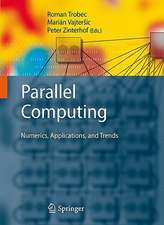Introduction to the Formal Design of Real-Time Systems: Applied Computing
Autor David F. Grayen Limba Engleză Paperback – noi 1998
Preț: 341.30 lei
Preț vechi: 426.63 lei
-20% Nou
Puncte Express: 512
Preț estimativ în valută:
65.30€ • 68.19$ • 53.93£
65.30€ • 68.19$ • 53.93£
Carte tipărită la comandă
Livrare economică 15-29 aprilie
Preluare comenzi: 021 569.72.76
Specificații
ISBN-13: 9783540761402
ISBN-10: 3540761403
Pagini: 476
Ilustrații: XIII, 461 p. 18 illus.
Dimensiuni: 155 x 235 x 25 mm
Greutate: 0.66 kg
Ediția:Softcover reprint of the original 1st ed. 1999
Editura: SPRINGER LONDON
Colecția Springer
Seria Applied Computing
Locul publicării:London, United Kingdom
ISBN-10: 3540761403
Pagini: 476
Ilustrații: XIII, 461 p. 18 illus.
Dimensiuni: 155 x 235 x 25 mm
Greutate: 0.66 kg
Ediția:Softcover reprint of the original 1st ed. 1999
Editura: SPRINGER LONDON
Colecția Springer
Seria Applied Computing
Locul publicării:London, United Kingdom
Public țintă
ResearchCuprins
1 Scene Set.- 1.1 Making Models.- 1.2 Lies, Damn Lies and Models.- 1.3 Abstraction, Atomicity and Algebras.- 1.4 Labelled Transition Systems.- 1.5 One at Once, All Together and In Time.- 1.6 Real-Time Systems.- 2 Concurrency and Communication.- 2.1 Concurrency - Defining the Problems.- 2.2 Programming Domain Solutions.- 2.3 Review and Rethink.- 3 Message Passing.- 3.1 Choosing the Best.- 3.2 Blocking Send.- 3.3 CCS (Calculus of Communicating Systems).- 3.4 Rendezvous.- 3.5 Conclusion.- 4 Synchronous Calculus of Communicating Systems.- 4.1 An Overview of SCCS.- 4.2 Plain SCCS.- 4.3 Recursion.- 4.4 Actions, Particles, Composites and All Sorts.- 4.5 Synchronisation.- 4.6 Constructional Design.- 4.7 Message Passing.- 4.8 Agents Lurking.- 4.9 Specifications and Proof.- 5 Equivalence.- 5.0 The Need For Equivalence.- 5.1 Traces.- 5.2 From Traces to Bisimulations.- 5.3 Bisimulation.- 6 Automating SCCS.- 6.0 Concurrency Work Bench: an Introduction.- 6.1 CWB and Agent Behaviours.- 6.2 Agents, Bisimulation and CWB.- 6.3 Comments.- 7 Proving Things Correct.- 7.1 Modal Logics.- 7.2 Modal Logic, CWB and Satisfaction.- 8 End End Note.- Appendix 1 Some of the More Useful SCCS Propositions.- Appendix 2 Notation Used Throughout the Book.- References.



























